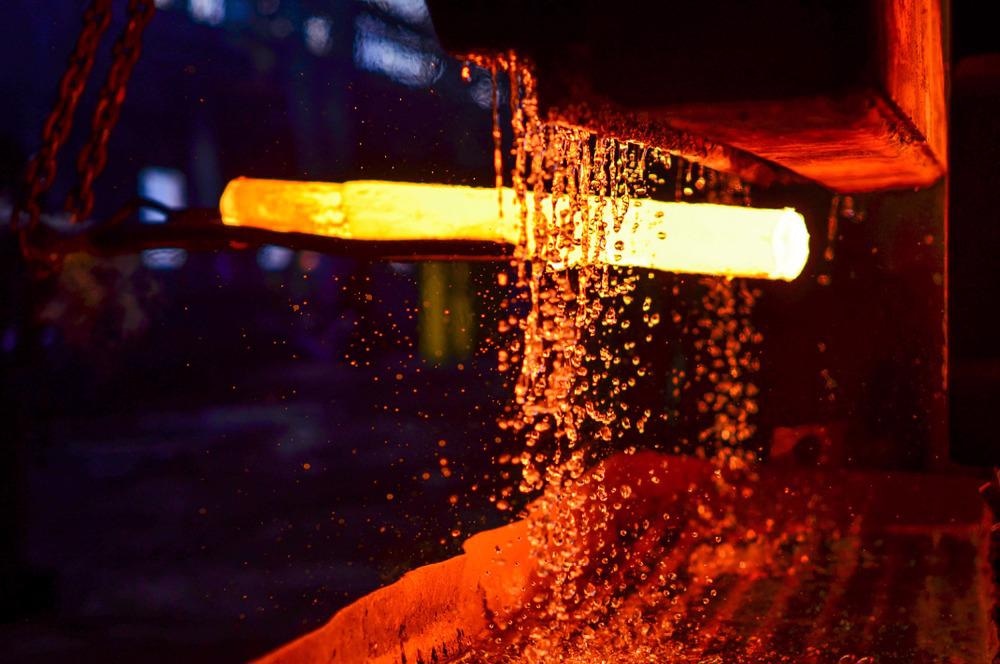
Image Credit: Maksim Safaniuk/Shutterstock.com
We use metals in construction, domestic appliances, vehicles, and many other everyday products. It really can be said that metals have built the modern world. To fine-tune the desired properties of commonly used metals they must be treated, either chemically or with heat treatment processes. This article will discuss annealing and tempering, two commonly used heat treatments.
Heat Treatment – An Overview
Mankind has worked metal for thousands of years. However, metal in its raw, untreated form does not have the correct properties for a wide range of uses. Consider iron, for example – in its raw form, it is too soft and cannot be used for construction purposes. Adding carbon to iron creates steel, but even steel does not have the desired properties unless it is treated. To produce a workable material, the carbon content and microstructure must be adjusted.
Heat treatment is typically performed in a succession of heating and cooling cycles. Desired properties that can be adjusted by heat treatment include hardness, tensile strength, ductility, grain size, toughness, magnetic properties, and electrical and heat conductivity. Internal stresses induced in cold working processes are relieved by certain heat treatments.
Temperature, holding times, and heating and cooling rates are varied according to the size, shape, and chemical composition of the material. Choosing the appropriate heat treatment method comes down to the type of metal and the required properties which need to be induced in the material.
Heat treatment processes that are commonly in use today include normalizing, hardening, aging, stress relieving, carburization, annealing, and tempering. There are fundamental differences between each process.
Annealing
Annealing is one of the most important and widely used heat treatment processes, used to treat both ferrous and non-ferrous metals. It alters the chemical and physical properties of the metal to increase its ductility, reduce its hardness, and make it more workable (in effect, softer.) This prepares the material for subsequent forming operations.
In this treatment process, the metal is heated to above its recrystallization temperature and then cooled after maintaining the temperature for an appropriate period. This causes the atoms to migrate in the crystal lattice of the metal and increase the number of dislocations in the atomic structure. This leads to a change in ductility and hardness. As it cools, the material recrystallizes. The material progresses toward its equilibrium state.
The cooling process differs for the type of metal being annealed. For ferrous metals such as steel, the metal is heated until glowing and then allowed to cool in still air at room temperature. Non-ferrous metals (copper, silver, and brass) can either be cooled slowly in this way or quickly by being quenched in water.
There are three stages in the annealing process that happen as the material is heated. These are recovery, recrystallization, and grain growth. In the recovery stage, primary linear defects known as dislocations, which cause internal stresses, are removed. Recrystallization produces strain-free grains which nucleate and grow to replace these. Finally, when annealing can continue past the recrystallization stage, grain growth occurs. The strength lost by annealing can be regained through hardening.
There are different types of annealing processes. These include normalization, process annealing, short cycle annealing, and a full anneal. Resistive heating is an annealing process that employs a controlled electrical short circuit and is used to efficiently anneal copper wire.
Tempering
Tempering works along the same principle as annealing. It softens metal by reducing brittleness and hardness while improving toughness and making it more ductile and therefore workable. However, the main difference between the two processes is that it generally refers to steel. Non-ferrous metals cannot be tempered.
Steel is created by adding carbon to iron. The simplest way of adjusting the properties of steel is to adjust the carbon content, but in its raw untreated form steel is incredibly fragile and prone to breaking. This makes it unsuitable as a material for use in applications such as construction.
Tempering is carried out as soon as the steel has been through the initial hardening and quenching process. If allowed to sit for too long after this initial quenching, the risk of internal fracturing within the steel increases. In tempering, the steel is once again heated to a higher temperature and then allowed to cool gradually. The cooling stage of the tempering process is usually carried out naturally in still air.
Adjusting the temperature makes different products suitable for specific needs. Low temperature creates steel usually used for cold work tools and case hardening components. Medium temperature tempering creates a more elastic product suitable for use in knives. Lastly, high-temperature tempering creates resilient and tough steel suitable for structural steel and machine components which require a durable material.
In Conclusion
The history of metalworking in human society has been a long and storied one, and the industry keeps evolving as knowledge increases and new technologies are developed. Both tempering and annealing are incredibly important heat treatment processes that are widely employed in industry to create the myriad of metal products we use today. This article has been a brief overview of these two vitally important heat treatment processes.
References and Further Reading
Britannica.com (Website) Treating of Steel [Accessed online 12 April 2021] https://www.britannica.com/technology/steel/Treating-of-steel
Boyer, H.E. (2013) Heat Treating of Non-Ferrous Alloys Metallurgy, Microstructures, and Analysis 2, pp. 190-195 [Accessed online 12 April 2021] https://link.springer.com/article/10.1007/s13632-013-0074-8
Learnmechanical.com (Website) Heat Treatment Process-Annealing, Normalizing, Hardening, Tempering, Nitriding, Cyaniding Process [Accessed online 12 April 2021] https://learnmechanical.com/heat-treatment/
Disclaimer: The views expressed here are those of the author expressed in their private capacity and do not necessarily represent the views of AZoM.com Limited T/A AZoNetwork the owner and operator of this website. This disclaimer forms part of the Terms and conditions of use of this website.